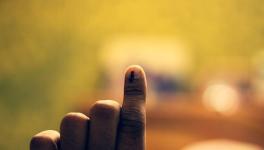COVID-19: It’s Not Over Yet in India
COVID-19 cases crossed 87 lakh (8.7 million) in India while the number of deaths was 1,28,722 on November 12, as the country is still struggling to get to terms with the pandemic. Although most of the economic activity has restarted gradually over the past five months, restrictions are still in place in educational institutions and many other activities of the past. But there is a marked shift of attention away from the pandemic both, by the government and the people, which could spell a disastrous resurgence in the coming weeks.
India continues to be second in the world in total number of confirmed cases, behind the US which is seeing a deadly surge in cases in the past months. This surge has been fuelled by an indifferent Trump administration, the hurried relaxing of various restrictions, and increased public activity in the recently concluded elections. Despite repeated and dire warnings by top scientists and medical experts, the cavalier attitude of the Trump regime has forced this tragedy on the US people, with a staggering 2,48,585 people dead and over 10 million recorded cases till date.
But what needs to be noted is that in India, the daily new cases remain the second highest in the world. [See chart below for November 12] Although 43,861 new Indian cases is one-fourth of the US tally on that day, but the fact remains that India is still not out of the woods yet.
India has gone through a peak around mid-September after which cases declined. This is best captured in the seven-day moving average chart shown below, where each date gives the daily average of the preceding seven days. Data has been collated by Newsclick’s Data Analytics Team from the health ministry’s website.
Cases touched an all-time weekly high of 93,199 around September 16, after which there has been a steady decline. This has been much celebrated by the government as an ‘achievement’ and several rounds of congratulations. There was understandable relief among people because the decline was happening after relaxation of several restrictions.
However, since around October 29, there has been an ominous flattening of the curve. [See chart above] Instead of falling further the cases have remained at the 45,000 mark more or less. This is worrying, though not completely unexpected.
It is worrying because it may presage another surge of cases as restrictions are further eased and people become complacent about taking the usual precautions. But more than that, the Central government seems to have become complacent about it, as have many of the state governments. We don’t see the Prime Minister warning the people about the pandemic any more. In fact, he recently was praising such outlandish things as the rising sales of ayurvedic products during the pandemic.
Testing is still going on but the urgency is no longer there. Tracing and isolation are no longer on the agenda and most state governments seem to have folded up on that, except some like the Kerala government, that has been facing the resurgence much more steadfastly.
For the past nearly 40 days, daily testing, as reported by the states, has hovered around the 11 lakh (1.1 million) mark. [See chart above] There are wide variations among states. What this implies is that COVID-19 may be spreading much more than is reflected in the recorded cases. This may lead to a situation later where the more severe cases, that need hospitalisation, could also increase. And, we would be back to square one.
The Narendra Modi government has failed to either contain the pandemic or save the sliding economy. In fact, without decisively dealing with the pandemic and controlling it, it will be impossible to revive the economy because the deadly disease will keep coming back.
What has been largely missing from the Central government’s response till date is income support to the vast number of working people which would ensure that they are not forced to expose themselves to the coronavirus. This would effectively curb the spread of the disease. This needs to be supplemented by complete healthcare coverage – free of cost – for those afflicted by the virus, whether mildly or severely. These measures must go hand in hand with all-out efforts to procure a viable vaccine (or many types of vaccines) as they emerge and put in place a plan for vaccination of the whole country.
If the Modi government does not lead the country in these efforts now, Indians will have to pay dearly in the coming days.
Get the latest reports & analysis with people's perspective on Protests, movements & deep analytical videos, discussions of the current affairs in your Telegram app. Subscribe to NewsClick's Telegram channel & get Real-Time updates on stories, as they get published on our website.
























